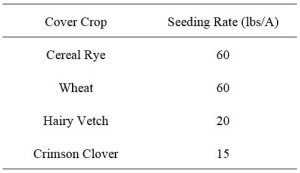A recent survey in Tennessee showed that 22% or our row crop acres were planted after a cover crop. In light of the PPO resistant Palmer amaranth we believe this number should go up as a good cover crop may help improve control of Palmer amaranth in an integrated system with herbicides. It is time to be making decisions about the cover crops you will be planting this fall. Cover crops have many attributes, however, we have been looking at them in weed control for about 6 years now. Like most other management decisions, which cover crop you choose and how you manage it is very dependent on your needs and the following cash crop. A simple way to think about your cover crop is like a PRE herbicide. This is two-fold, in that it will help supplement your PRE, and also in that you pick and choose PRE herbicides based on your cash crop.
Legume cover crop species (i.e. hairy vetch; crimson clover) are good options in front of corn or cotton. These covers offer the benefit of early season N to help the crop get out of the ground and still provide substantial biomass to aid in weed control. In general, hairy vetch is easier to control and will provide slightly more above ground biomass than that of crimson clover. In our research, crimson clover requires a combination of herbicides such as glyphosate + dicamba or paraquat + metribuzin, or sequential herbicide applications to attain adequate control. However with hairy vetch, glyphosate + planter will be sufficient, making termination pretty simple. Each of these cover crops has the ability for large amounts of biomass, which will translate into weed suppression. However, this will be dependent on what crop you are planting, or more importantly when you terminate. In general, biomass from hairy vetch and crimson clover deteriorate faster than that of wheat or cereal rye, so scouting and a timely application of a residual herbicide will be important in the following cropping season.
Grass cover crop species (i.e. wheat; cereal rye) will deteriorate slower and provide biomass that is similar to that of the legume species above. These species are also very good for early season suppression of Palmer amaranth. Although cereal rye is thought of as being a very high biomass cover, in the past we have gotten greater biomass from wheat unless termination/planting is delayed until approximately mid- to late-May. Also if grass covers are going in front of cotton or corn, waiting until <14 days until planting to terminate could negatively impact the early season growth of your cash crop. Generally, soybeans are very tough in the early season and can be planted into very high biomass grass or legume species cover crops with no negative impacts on crop growth.
Cover crop mixtures are another option to consider and can also increase the amount of early season weed suppression. One of our favorite cover crop mixtures for weed control is hairy vetch mixed with either wheat or cereal rye. Either of these mixtures will provide greater biomass and better ground coverage than any of these species alone. Also, when vetch grows with a grass species, it will ‘creep’ up the grass species and fold it down to the ground when it is planted through, giving a similar effect as if it were rolled. Mixtures also provide flexibility for the following cash crop. Cover crop termination timing with the mixtures can be adjusted for the following cash crop to allow a cover crop mixture to work well in corn, cotton, or soybeans.
The seeding rates of the aforementioned cover crops are in the table below. If going with a mixture, use a combination of the seeding rates below. Again, there are many other cover crop options available that may fit your needs, however, these are the ones that we have been examining.
Finally, a lot of folks worry about vetch cover turning into a weed problem in wheat. This is a valid concern. However, it can be managed with a simple application of 2,4-D or dicmaba applied POST to the wheat in the fall.



One thought on “Cover Crop Considerations for This Fall”
Comments are closed.